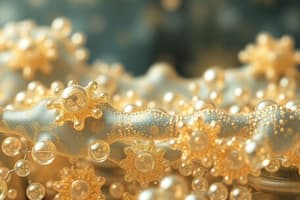Podcast
Questions and Answers
An antiporter and a symporter are examples of:
An antiporter and a symporter are examples of:
- Primary active transporters
- Passive diffusion
- A secondary transporter (correct)
- Entropy-driven pores
- An ABC transporter
What force(s) stabilize(s) the lipid bilayers?
What force(s) stabilize(s) the lipid bilayers?
- Covalent bonds between the lipid tails
- Covalent bonds between the lipids and membrane proteins
- Van der Waals interactions
- Electrostatic and hydrogen bonding between the polar heads and surrounding water
- A and B (correct)
Why do phospholipids and glycolipids form bimolecular sheets?
Why do phospholipids and glycolipids form bimolecular sheets?
Due to the presence of two fatty acyl chains.
In the movement of small molecules across a lipid bilayer, what is most correlated with the permeability coefficient?
In the movement of small molecules across a lipid bilayer, what is most correlated with the permeability coefficient?
What is the most common way integral membrane proteins span the membrane?
What is the most common way integral membrane proteins span the membrane?
What would be expected to lower the Tm for a phospholipid bilayer?
What would be expected to lower the Tm for a phospholipid bilayer?
In passive transport, what provides the energy for movement across a membrane?
In passive transport, what provides the energy for movement across a membrane?
What does the Na+-K+ pump do?
What does the Na+-K+ pump do?
What distinguishes symporters from antiporters in secondary transporters?
What distinguishes symporters from antiporters in secondary transporters?
Which of the following is NOT true of ion channels?
Which of the following is NOT true of ion channels?
Flashcards are hidden until you start studying
Study Notes
Transport Mechanisms
- Antiporters and symporters are types of secondary transporters involved in moving substances across membranes.
- Passive transport relies on the concentration gradient for energy, without the need for ATP.
Lipid Bilayers
- Lipid bilayers are stabilized by van der Waals interactions and hydrogen bonding between polar head groups and surrounding water.
- Salts of fatty acids form micelles, while phospholipids and glycolipids form bimolecular sheets due to the presence of two fatty acyl chains.
Permeability and Solubility
- The permeability of small molecules across lipid bilayers is most closely correlated with their solubility in nonpolar solvents.
- Integral membrane proteins commonly span the membrane in α-helical segments, which contribute to stability and function.
Membrane Fluidity and Composition
- Transition temperature (Tm) for phospholipid bilayers can be lowered by replacing longer-chain fatty acids with shorter ones, impacting membrane fluidity.
- Ion channels allow rapid ion movement and are highly specific, but they are gated and not always open. This contrasts with pumps and secondary transporters which require energy to operate.
Sodium-Potassium Pump
- The Na+-K+ pump is crucial for maintaining cellular ion balance by pumping sodium out of the cell and potassium into the cell, utilizing active transport.
Secondary Transporters
- Secondary transporters, like symporters and antiporters, differ in their movement direction: symporters transport two molecules in the same direction while antiporters move them in opposite directions.
Ion Channels vs. Pumps
- Ion channels enable faster ion transport compared to pumps or secondary transporters which depend on energy sources. Ion channels can be gated and are designed for specific substrates.
Studying That Suits You
Use AI to generate personalized quizzes and flashcards to suit your learning preferences.





